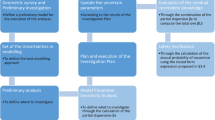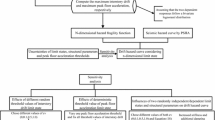Abstract
Probabilistic seismic assessment requires extensive computational effort resulting from variability both in input ground motions and mechanical properties. Nonetheless, such methodologies are of considerable importance, namely for pre-earthquake disaster planning or development of retrofitting programs. A framework for the analytical definition of closed form expressions for exceedance probabilities of structural component limit states, defined by limit values of structural response parameters, is proposed herein. The definition of these expressions is based on the probabilistic representation of the ground motion intensity and on the establishment of suitable expressions characterizing the evolution of structural demand with increasing earthquake intensity. Distinction is made between deformation-based and force-based structural parameters in the definition of such relations. Within the proposed framework, the limit states are defined by single deterministic thresholds of structural response quantities at the component level, as defined in structural codes. Different approaches are also discussed to account for the randomness of the mechanical properties and ground motion input within the proposed methodology. An application of the assessment of different limit state probabilities of members from a reinforced concrete building is presented, for which limit states and limit state capacities are defined according to the upcoming Part 3 of the Eurocode 8. Although the presented application only deals with member chord rotation and shear force limit state probabilities, the proposed methodology can be generalized to other deformation-based and force-based structural parameters.
Similar content being viewed by others
References
Ambraseys N, Smit P, Sigbjornsson R, Suhadolc P, Margaris B (2002) Internet-Site for European strong-motion data. Euro Comm Research-Directorate General, Environ Climate Programme
Arêde A, Pinto AV (1996) Reinforced concrete global section modelling: definition of skeleton curves. Special Publication No.I.96.36. Institute for Systems, Informatics and Safety, Joint Research Center, Ispra, Italy
Aslani H (2005) Probabilistic earthquake loss estimation and loss disaggregation in buildings. PhD Thesis, John A. Blume Earthquake Engineering Center, Dept. of Civil and Environmental Engineering, Stanford University, Stanford, CA
ATC (1985) ATC-13: Earthquake damage evaluation data for California. Applied Technology Council, Redwood City, CA, USA
Au SK, Beck JL (2003) Subset simulation and its application to seismic risk based on dynamic analysis. J Eng Mech 129(8): 901–917
Carvalho EC, Coelho E, Campos-Costa A (1999) Preparation of the full-scale tests on reinforced concrete frames—Characteristics of the test specimens, materials and testing conditions. ICONS report, Innovative Seismic Design Concepts for New and Existing Structures, European TMR Network, LNEC, Lisbon
Castillo E (1988) Extreme value theory in engineering. Statistical Modeling and Decision Science. Academic Press, New York
CEB (1996) RC frames under earthquake loading. Bulletin no. 231, Comité Euro-International du Béton
CEN (2004) European Committee for Standardization, Eurocode 8: Design of structures for earthquake resistance, Part 3: Assessment and retrofitting of buildings. Final draft
Cornell CA (1968) Engineering risk analysis. Bull Seismol Soc Am 58(5): 1583–1606
Cornell CA, Jalayer F, Hamburger R, Foutch D (2000) Probabilistic basis for the 2000 SAC/FEMA steel moment frame guidelines. J Eng Mech 128(4): 526–533
Der Kiureghian A (1996) Structural reliability methods for seismic safety assessment: a review. Eng Struct 18(6): 412–426
Dymiotis C, Kappos AJ, Chryssanthopoulos MC (1999) Seismic reliability of R/C frames with uncertain drift and member capacity. J Struct Eng 125(9): 1038–1047
Franchin P (2004) Reliability of uncertain inelastic structures under earthquake excitation. J Eng Mech 130(2): 180–191
Giannini R (2000) MATHazard: a program for seismic hazard analysis. University of Rome
Giovenale P, Cornell CA, Esteva L (2004) Comparing the adequacy of alternative ground motion intensity measures for the estimation of structural responses. Earthquake Eng Struct Dyn 33(8): 951–979
Hadjian AH (2002) A general framework for risk-consistent seismic design. Earthquake Eng Struct Dyn 31(3): 601–626
Haukaas T (2003) Finite element reliability and sensitivity analysis of hysteretic degrading structures. PhD Thesis, University of California, Berkeley, California
Hendawi S, Frangopol D (1994) System reliability and redundancy in structural design and evaluation. Struct Safety 16(1–2): 47–71
Jalayer F, Cornell CA (2000) Technical framework for probability-based demand and capacity factor (DCFD) seismic formats. RMS Technical Report No.43 to the PEER Center, Department of Civil and Environmental Engineering, Stanford University, Stanford, CA
Kennedy RC, Short SA (1994) Basis for seismic provisions of DOE-STD-1020. UCRLCR-111478 and BNL-52418, Lawrence Livermore National Laboratory and Brookhaven National Laboratory Report
Krawinkler H, Zareian F, Medina RA, Ibarra L (2006) Decision support for conceptual performance-based design. Earthquake Eng Struct Dyn 35(1): 115–133
Kurama YC, Farrow KT (2003) Ground motion scaling methods for different site conditions and structure characteristics. Earthquake Eng Struct Dyn 32(15): 2425–2450
LessLoss (2004) LessLoss—Risk mitigation for earthquakes and landslides. Integrated Research & Development Project of the European Commission, Contract No. GOCE-CT-2003–505448. http://www.lessloss.org/. Cited 22 Oct 2006
LessLoss (2006) LessLoss—Risk Mitigation for Earthquakes and Landslides. Applications of probabilistic seismic assessment methods to selected case studies. Technical Report No. 78. Integrated Research & Development Project of the European Commission
Luco N, Bazzurro P (2004) Effects of earthquake record scaling on nonlinear structural response. Report for PEER Center Lifelines Program—Task 1G00, Pacific Earthquake Engineering Research Center, UC Berkeley, Berkeley, California
Lupoi A, Franchin P, Schotanus MIJ (2003) Seismic risk evaluation of RC bridge structures. Earthquake Eng Struct Dyn 32(8): 1275–1290
Matlab (2006) The MathWorks, Inc. http://www.mathworks.com/. Cited 22 Oct 2006
McGuire RK (1976) A FORTRAN computer program for seismic risk analysis. United States Department of the Interior Geological Survey
McKay MD, Beckman RJ, Conover WJ (1979) A comparison of three methods for selecting values of input variables in the analysis of output from a computer code. Technometrics 21(2): 239–245
Medina RA, Krawinkler H (2004) Seismic demands for nondeteriorating frame structures and their dependence on ground motions. Report PEER 2003/15, Pacific Earthquake Engineering Research Center, UC Berkeley, Berkeley, California
Moses F (1990) New directions and research needs in system reliability. Struct Safety 7(2–4): 93–100
Pinto PE (2001) Reliability methods in earthquake engineering. Progress in Struct Eng Mate 3(1): 76–85
Pinto PE, Giannini R, Franchin P (2004) Seismic reliability analysis of structures. IUSS Press Istituto Universitario di Studi Superiori di Pavia: Pavia, Italy
Rocha P, Delgado P, Costa A, Delgado R (2004) Seismic retrofit of RC frames. Comput Struct 82(17–19): 1523–1534
Sabetta F, Pugliese A (1996) Estimation of response spectra and simulation of nonstationary earthquake ground motions. Bull Seismol Soc Am 86(2): 337–352
Schotanus MIJ, Franchin P, Lupoi A, Pinto PE (2004) Seismic fragility analysis of 3D structures. Struct Safety 26(4): 421–441
Singhal A, Kiremidjian A (1998) Bayesian updating of fragilities with application to RC frames. J Struct Eng 124(8): 922–929
Shinozuka M, Feng MQ, Lee J, Naganuma T (2000) Statistical analysis of fragility curves. J Eng Mech 126(12): 1224–1231
Shome N, Cornell CA, Bazzurro P, Carballo IE (1998) Earthquakes, records and non-linear responses. Earthquake Spectra 14(3): 469–500
Stewart JP, Chiou SJ, Bray JD, Graves RW, Somerville PG, Abrahamson NA (2001) Ground motion evaluation procedures for performance-based design. Report PEER-2001/09, Pacific Earthquake Engineering Research Center, UC Berkeley, Berkeley, California
Thoft-Christensen P, Murotsu Y (1986) Application of structural systems reliability theory. Springer Verlag, Berlin, Germany
Vamvatsikos D, Cornell CA (2002) Incremental dynamic analysis. Earthquake Eng Struct Dyn 31(3): 491–514
Varum H (1997) Numerical model for the seismic analysis of reinforced concrete plane frames. MSc Thesis, Faculty of Engineering of the University of Porto, Porto, Portugal (in Portuguese)
Zwillinger D, Kokoska S (2000) CRC standard probability and statistics tables and formulae. Chapman & Hall/CRC
Author information
Authors and Affiliations
Corresponding author
Rights and permissions
About this article
Cite this article
Romão, X., Guedes, J., Costa, A. et al. Analytical evaluation of structural component limit state probabilities. Bull Earthquake Eng 6, 309–333 (2008). https://doi.org/10.1007/s10518-007-9056-z
Received:
Accepted:
Published:
Issue Date:
DOI: https://doi.org/10.1007/s10518-007-9056-z




